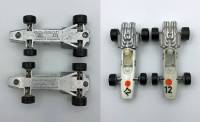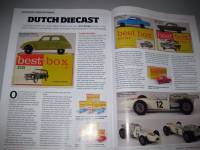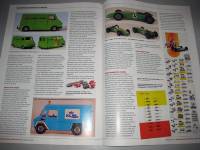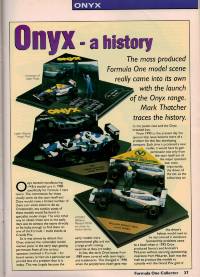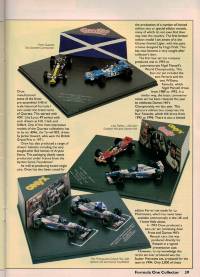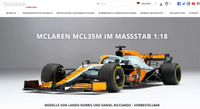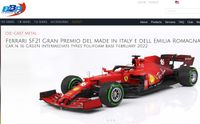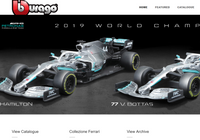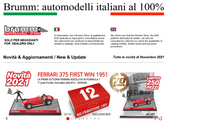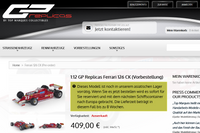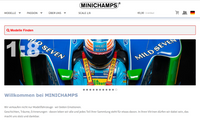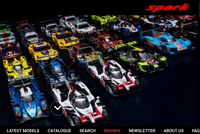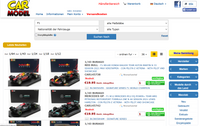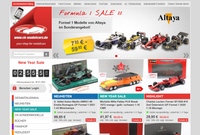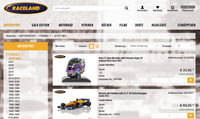Manufacturers from the Rest of the World
Bestbox/Efsi (Netherlands/Niederlande)
The first Bestbox models from the Netherlands emerged in 1962. The company's name shows that they had a lot of similarity with Matchbox. But they were less popular. In 1966 Bestbox released a series of Formula One cars in 1:55 including a BRM (2509), a Honda (2512), a Ferrari (2517), a Brabham (2518), a Cooper Maserati (2519) and a Lotus (2520). The sixtet was able to take it up with the Matchbox rivals. Many collectors even describe the Bestbox models as better proportioned and more detailed. A fact that maybe helped Bestbox to get a special order from Dinky Toys. The British die-cast manufacturer wanted to introduce an own small sized series, the so-called Mini Dinky Toys. Bestbox took existing moulds and produced among others a green Lotus and a blue Cooper. Dinky Toys sold the duo in red plastic garages. Which made the models a real eye-catcher. At the beginning of the 1970s Bestbox changed its name to Efsi. The suspicion that Matchbox had put pressure behind the scenes and wanted to ban the similar sounding company name is obvious but not proven. The abbreviation «fsi» stands for «Fonds voor Sociale Instellingen». And it was a political decision. At the end of the sixties several coal and peat mines were closed in the province of Limburg where Bestbox was based. The Dutch State Mines (DSM) who was responsible for the closures tried to create new jobs for the approximately 60’000 unemployed miners – among others in social workshops. One of the activities of such a workshop was the modelcar production of Bestbox.
Almost all of the Formula One models which were available from Bestbox were relaunched under the new company name – with one exception: the Cooper-Maserati. The numbers changed as follows: The BRM was given the number 201, the Honda became 202, Ferrari (203), Brabham (204) and Lotus (206). The series was completed with a nice McLaren (No. 205). While the first two numbers were identical to the models of Bestbox (apart from wider tires) the other four got some wings at the back and the front. Since 1995 the former Bestbox company belongs to the Holland-Oto B.V., a modelcar manufacturer based in Weert at Eindhoven which was founded in 1994 and which is specialized in truck miniatures. The prizes for Bestbox and Efsi Formula One models are between 20 and 30 Euro. It depends on the packaging which was for surenicer when the company was called Bestbox. Sources say that there also exist a giftset with five Formula One models from Efsi. I haven't seen this one yet. But I am pretty sure it won't be cheap.
Muovo (Finland/Finnland)
Muovo (more precisely muovi) is Finnish and means plastic. It was precisely from this material that the Finns produced some «Kinder surprise models» for the confectionery companies Chymos and Panda from the mid-1950s on. First Muovo concentrated on the H0 scale (eight different cars in 1:87), followed later by models in 1:60 and 1:50. Five of these were Formula One cars. Such as a Maserati 250F, a Mercedes W196, which was available as a streamlined and a open version, a Cooper 1.5-litre and a Scarab. The latter is not only the rarest in this quintet it is in general a big surprise that a manufacturer from Finland produced this car. Scarab was a US sports car company which gave its debut in Formula One in 1960. Which was quite late if you consider the concept of the car. They used a front engine for the Formula One Scarab whereas the competitors from Europe had switched to rear engines already. So it was no surprise that Scarab was completely unsuccessful. The models of Muovo do not always have the right color. For example: the two Mercedes are available in blue. Or in silver with a red bottom. But the forms are well done. And a few details such as the suggested rivets at the Maserati or the starting numbers prove that the Finns have made a few investigations before producing the models. In addition to the Formula One racers Muovo also did some sports cars and record cars. All of them are rare today. And prices of 100 Euro per piece are not unusual.
Muovo (genauer gesagt muovi) ist finnisch und heisst Plastik. Und genau aus diesem Material waren die Modelle, die die Finnen Mitte der Fünfzigerjahre als beigelegte «Kinder-Überraschung» für die Süsswaren-Unternehmen Chymos und Panda produzierten. Zuerst konzentrierte sich Muovo auf den H0-Massstab 1:87 (acht verschiedene Personenwagen), später folgten Modelle in 1:60 und 1:50. Fünf Formel-1-Fahrzeuge zählte das Sortiment von Muovo. Dazu gehörten ein Maserati 250F, ein Mercedes W196, den es offen und als Stromlinienversion gab, ein Cooper 1,5-Liter sowie ein Scarab. Letzterer ist nicht nur der seltenste in diesem Quintett, es ist überhaupt eine Überraschung, dass sich ein Modellhersteller diesem Fahrzeug widmete. Und dann ausgerechnet noch einer aus Finnland! Scarab war ein US-Sportwagen-Hersteller, der 1960 in der Formel 1 debütierte. Allerdings hatten die Amis die Zeichen der Zeit komplett verschlafen. Sie setzten beim Scarab auf einen Frontmotor, wogegen die Konkurrenz aus Europa schon längst auf Heckmotoren umgestellt hatte. Dementsprechend erfolglos war das Unternehmen. Die Modelle von Muovo sind farblich nicht immer korrekt. So sind beispielsweise die beiden Mercedes in blau erhältlich. Oder in silber mit einem roten Boden. Aber die Formen sind ganz gut gelungen. Und ein paar Details wie zum Beispiel die angedeuteten Nieten am Maserati oder auch die Startnummern beweisen, dass die Nordländer sich beim Bau der Modelle doch einige Gedanken gemacht haben. Neben den F1-Rennern gab es bei Muovo auch noch Sportwagen und Rekordfahrzeuge. Alle sind heute sehr selten. Liebhaber zahlen deshalb gerne bis zu 100 Euro pro Stück.
Onyx (Portugal)
Onyx was the first not only to recognize the growing interest in Formula One at the end of the 1980s. The company from Portugal also successfully launched the four top-runners in 1:43 in 1989. Even before Minichamps placed its first Formula One miniatures on the market the subsidiary company of Vitesse had largely covered the years 1988, 1989 and 1990. Some of them in original tobacco livery. As for example the McLaren-Honda MP4/4 and the Lotus-Honda 100T from 1988. Until 1989 the models were packed in smart cardboard boxes with the appropriate team and sponsorship logos. For those times the models were of good but not sensational quality. Especially the suspensions left much to be desired. Stiff front and rear axles made the models look like toys – until 1990. Until 1993 the cars had no mirrors, too. And also the printing technique is not comparable with todays methods. Nevertheless one should not forget that there was no alternative at this time in the die-cast range. Only white metal kits like Tameo or Meri Kit offered better quality. But the costs for these models were ten times more than what a collector had to afford for a Onyx modelcar. When Minichamps launched the first Formula One model cars the Germans not only set new standards, between Aachen and Oporto there was also a tough struggle for production licenses. There were stages when both manufacturers had the right to produce certain brands. For example Michael Schumacher's world champion winning Benetton B194. But in the end the better quality of Minichamps came out on top. In 1997 Onyx launched the Sauber C17 under exclusively license. It was the last Formula One model car which was produced by the Portugues company.
«Stiff axles made the models look like toys.
But there was no alternative until Minichamps captured
the market at the beginning of the nineties.» f1modelcars.com
One year before Vitesse launched a new label: «Quartzo» – which started with the Lotus 49 of 1967 and focused on historical cars. In addition to the classic scale of 1:43 Onyx also had some models in 1:18 and 1:24 in its range. Sometimes the Iberians «cheated» a little bit. For example: They took the same moulds for the Williams FW14 and the Ligier JS37. Again and again there were curiosities due to licensing. In 1993 the McLaren-Ford MP4/8 from Ayrton Senna and Michael Andretti appeared with the designation «Formula 1 Car». With attached stickers the collector had to give the models the finishing touches. The reason: Onyx was prohibited from selling the models as clearly identifiable McLaren Formula One cars. There were also problems due to the imprudent licensing requirements of Nigel Mansell (1994) and Jos Verstappen (1996). Both models have been released without the accurate helmet design of the driver. The rarest 1:43 is the flat-snappy Benetton B190B driven by Nelson Piquet and Roberto Moreno which was circulated unnumbered. Also special models from Göde or Brazil (called VC models) are a rarer. In general however Onyx models are often found. And therefore also inexpensive due to the quality. But also because numerous models which Onyx brought to market at that time are available today from Minichamps or Spark in a much better quality. Although Vitesse (founded in 1982) covered a wide range of racing models the company was liquidated in 2001. The remaining stocks became the property of the «Sun Star Group» from Macau which has given the name of Vitesse a fresh look. Official site: www.vitessemodels.com
Onyx hatte das steigende Interesse an der Formel 1 Ende der Achtzigerjahre als Erster erkannt und erfolgreich in 1:43er-Modelle umgesetzt. Noch bevor Minichamps 1991 die ersten Formel-1-Miniaturen auf den Markt brachte, hatte die portugiesische Vitesse-Tochter die Jahrgänge 1988, 1989 und 1990 größtenteils abgedeckt. Den McLaren-Honda MP4/4 und den Lotus-Honda 100T schickte Onyx – damals noch legal – mit und ohne Tabakwerbung ins Rennen. Bis 1989 waren die Modelle in schmucken Kartonschachteln mit entsprechenden Team- und Sponsorenlogos verpackt. Für damalige Verhältnisse waren die Modelle von guter, aber nicht perfekter Qualität. Abstriche musste der Sammler vor allem bei den Radaufhängungen machen. Steife Vorder- und Hinterachsen ließen die Modelle bis einschließlich 1990 wie Spielzeug aussehen. Erst ab 1993 versah Onyx die Modelle mit Rückspiegeln. Auch die Bedruckung ließ anfangs zu wünschen übrig. Dennoch darf man nicht vergessen, dass zu diesem Zeitpunkt keine Alternative bestand. Wer sich die F1-Modelle der späten 80er-Jahre in die Vitrine stellen wollte, konnte im besten Fall auf White Metal Kits zurückgreifen. Die kosteten aber fast das Zehnfache der Onyx-Miniaturen. Als Minichamps 1992 die ersten Konkurrenz-Produkte auf den Markt brachte, setzten die Deutschen nicht nur neue Maßstäbe, es begann zwischen Aachen und Oporto auch ein zähes Ringen um die Produktionslizenzen. Phasenweise hatten beide Hersteller das Recht an gewissen Fabrikaten. So beispielsweise an Michael Schumachers Weltmeister-Benetton 1994. Letztendlich setzte sich aber die bessere Qualität von Minichamps durch. 1997 erschien mit dem exklusiv unter Sauber-Lizenz gebauten C17 der letzte Onyx-Renner in 1:43.
«Steife Achsen liessen die Modelle wie Spielzeug aussehen.
Aber es gab keine Alternative, bis Minichamps Anfang
der Neunzigerjahre den Markt eroberte.» f1modelcars.com
Ein Jahr zuvor startete Vitesse unter dem Label «Quartzo» eine neue Serie, die ihren Anfang mit dem Lotus 49 von 1967 nahm und sich auf historische Modelle konzentrierte. Neben dem klassischen Sammlermaßstab wagte sich Onyx auch an die Baugrößen 1:18 und 1:24. Dabei drückte man in Sachen Genauigkeit schon mal ein Auge zu und verwendete beispielsweise für den Williams FW14 und den Ligier JS37 dieselbe Modellform. Immer wieder kam es aufgrund der Lizenzvergaben zu Kuriositäten. So erschien 1993 der McLaren-Ford MP4/8 von Ayrton Senna und Michael Andretti mit der Bezeichnung «Formula 1 Car». Mit beigelegten Aufklebern musste der Sammler dem Modell selber den letzten Schliff geben. Onyx war es untersagt, die Modelle als eindeutig identifizierbare McLaren-Fahrzeuge zu verkaufen. Probleme gab es auch wegen überrissenen Lizenz-Forderungen bei den Modellen von Nigel Mansell (1994) und Jos Verstappen (1996). Der seltenste 1:43er ist der flachschnauzige Benetton B190B von Nelson Piquet und Roberto Moreno, der ohne Nummer in Umlauf gebracht wurde. Auch Sondermodelle von Göde oder aus Brasilien (VC Models genannt) sind etwas rarer. Im Allgemeinen sind Onyx-Modelle aber oft anzutreffen. Und daher auch ziemlich günstig, was natürlich in erster Linie an der Qualität liegt. Aber auch daran, dass zahlreiche Modelle, die Onyx damals auf den Markt brachte, längst auch von Minichamps, Spark oder anderen Anbietern erhältlich sind. Obwohl Vitesse (1982 gegründet) ein breites Spektrum an Rennsportmodellen abdeckte und so eigentlich über eine große Käuferschaft verfügte, wurde die Firma 2001 liquidiert. Die Restbestände gingen in den Besitz der «Sun Star Group» aus Macau über, die dem Namen Vitesse seither zu neuem Glanz verhilft. Offizielle Seite: www.vitessemodels.com
